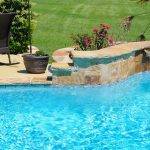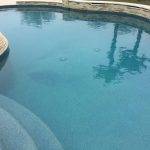It is important to be aware of the calcium hardness (CH) level of your water. The CH level is especially important for pools with surfaces below the
If there is too much calcium in the water, calcium scale can form on the pool and in the plumbing, and the water can become clouded with calcium dust. If there is too little calcium in the water, and you have a surface containing calcium (plaster / marcite / pebble / grout), calcium from the pool surface can dissolve into the water, causing pitting and deterioration thereby shortening the life of your finish.
The risk of calcium scale, clouding, and pitting depends not just on the calcium level, but also on the PH, total alkalinity, and several other factors. The Calcium Saturation Index (CSI) is a single number showing the overall risk for scaling or pitting. PH actually has the largest impact on the CSI, more than calcium does! If you allow your PH to get too high, there is a significant risk of calcium scaling.
You can use PoolMath to find out your CSI. You can also use the similar, but somewhat less accurate, Langelier Saturation Index (LSI), which is easier to calculate by hand but is less precise.
To prevent scaling, you should keep your CSI below 0.6 at all times. Pools with surfaces containing calcium also need to have their CSI above -0.6 at all times to prevent pitting. Vinyl, fiberglass, and painted pools can safely have a significantly negative CSI. The CSI is very sensitive to PH changes. With surfaces containing calcium you normally try to balance your CSI fairly close to zero so that future PH swings will still leave the CSI within these bounds.
Calcium also serves other purposes. If you have a spa, it is best to keep the CH level at 150 or higher to reduce foaming. CH levels around 220-320 are recommended for fiberglass pools, to protect the gelcoat and somewhat reduce the severity of metal stains.
In some parts of the country, the available fill water has high levels of CH. Combined with high rates of evaporation in arid areas, this can rapidly raise the CH level in the pool. CH levels up to perhaps 1,200 can be managed by reducing your TA and carefully keeping your PH relatively low. Usually the most practical way to lower CH levels is to replace water. If replacement water is extremely expensive you can also use a reverse osmosis water treatment to lower CH, along with all of your other levels.
Calcium scale can be very difficult to remove. Small patches of scale can be removed with a pumice stone. In mild cases, lowering your CSI to about -0.8 and brushing aggressively can sometimes remove scale, particularly when a sequestrant designed for calcium is also used, but this can take weeks and you need to be careful not to lower your PH too far of you can damage copper heat exchange coils. There are no drain acid wash systems, such as Jack’s Magic The Copper & Scale Stuff, but the heater (if any) must be bypassed and the process can take weeks. The only reliable solution for removing calcium scaling is a full drain and acid wash.





